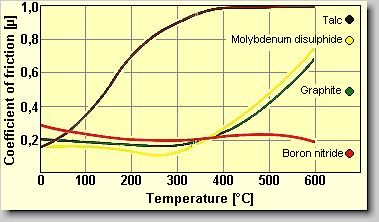Coefficients of Friction for Graphite
An educational, fair use website
| Bibliographic Entry | Result (w/surrounding text) |
Standardized Result |
|---|---|---|
| Lide, David R. CRC Handbook of Chemistry and Physics. Boca Ranton, Fl.: CRC Press, 1994: 15-40. | "Graphite on graphite in a clean or lubricated condition has a static coefficient of friction of 0.1" | 0.1 |
| Ruan, Ju- Ai and Bhushan, Bharat "Frictional Behavior of Highly Oriented Pyrolytic Graphite." Journal of Applied Physics. Vol. 76. 12/ 15/ 94: 8117-20. | "It is observed that the coefficient of friction is extremely small (<0.006) for a freshly cleaved HOPG surface of (0001) plane." | (<0.006) |
| Peterson, Johnson, Marshall B. Friction studies of graphite and mixtures of graphite with several metallic oxides and salts at temperatures to 1000 F. Technical Note 3657. National Advisory Committee for Aeronautics (NACA). February 1956. | "The friction coefficient was initially low (0.05 to 0.1) and then increased to a rather steady value (0.12 to 0.16)." | (0.05–0.1) |
| Rudolph, Stephan. Coefficient of friction of ceramic materials. Büro für angewandte Mineralogie. | [see diagram below] | 0.2–0.6 |

Graphite is one of the elements commonly seen by everyone everyday, but no one really thinks about it. Nearly every school day we use it in math class for recording notes and taking tests. Graphite is found in pencils. It is an allotrope of carbon, meaning it has a structurally different form of carbon. It is black silver in color with a metallic luster and black gray to brownish gray streaks. When picked up by the hand, washable black marks are left on the hand. Graphite is also a conductor of electricity. As diamond is the hardest mineral known by man, graphite is one of the softest mineral.
Friction is quantified through the coefficient of friction, μ. Friction is a value of the measurement of the force between two objects when they are rubbed against each other, or the force that keeps the objects stuck together. There are generally two types of friction: kinetic and static. Kinetic friction occurs when two objects are moving and rub against each other. Static friction occurs when two bodies are in contact with each other and they both aren't moving. The coefficient of friction that exists between two bodies is the ratio of the force required to move one surface over the other to the total force keeping the bodies together, friction.
The static coefficient of friction of graphite on graphite is 0.1, (there are no units), and for graphite on graphite in a vacuum it's 0.5- 0.8.
When graphite is heated up to high temperatures the coefficient of friction also increases gradually. Such as at zero degrees Celsius its 0.2 and remains constant at that value until temperatures reach 350 degrees Celsius the coefficient would increase to 0.22 and at 500 degrees Celsius it's 0.4.
Graphite is also a widely used lubricant, which means it can help to reduce friction between surfaces. Usually it is applied to car tires to make the car travel a tad faster, since it reduces the friction between the floor and the tire of the car.
Nina Chen -- 2004